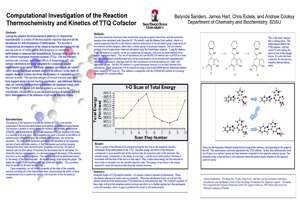 |
||||||||
 |
 |
 |
 |
 |
| Computational Investigation of the Reaction Thermochemistry and Kinetics of TTQ Cofactor | ||
|
Among the simplest electrobiochemical pathways
to characterize experimentally is a series of electron transfer
reactions that provide the mechanism for dehydrogenation of methylamine.
We describe a computational investigation of the chemical reaction
mechanism for the enzyme activity of methylamine dehydrogenase in
converting methylamine to ammonia and formaldehyde, focusing on
the activity of the cofactor tryptophan tryptophylquinone (TTQ).
The free energies, reaction rate constants, and related effects
of temperature, pH, and isotopic substitution are being computed
for comparison against experimental observations. Electronic structure
calculations are carried out by density functional methods shown
to be effective in the study of simpler chemical systems involving
the dynamics of conjugated pi-electron systems. The reaction
| ||
|
energies of several reaction steps have been
mapped along selected reaction coordinates, and additional reaction
steps are currently being probed to determine the minimum energy
path. The COSMO-RS model will then be applied to account for the
considerable solvent effects in ion-mediated reaction dynamics,
and will allow determination of the influence of pH on the reaction
system.
|
||
| • Other Abstracts • | ||
